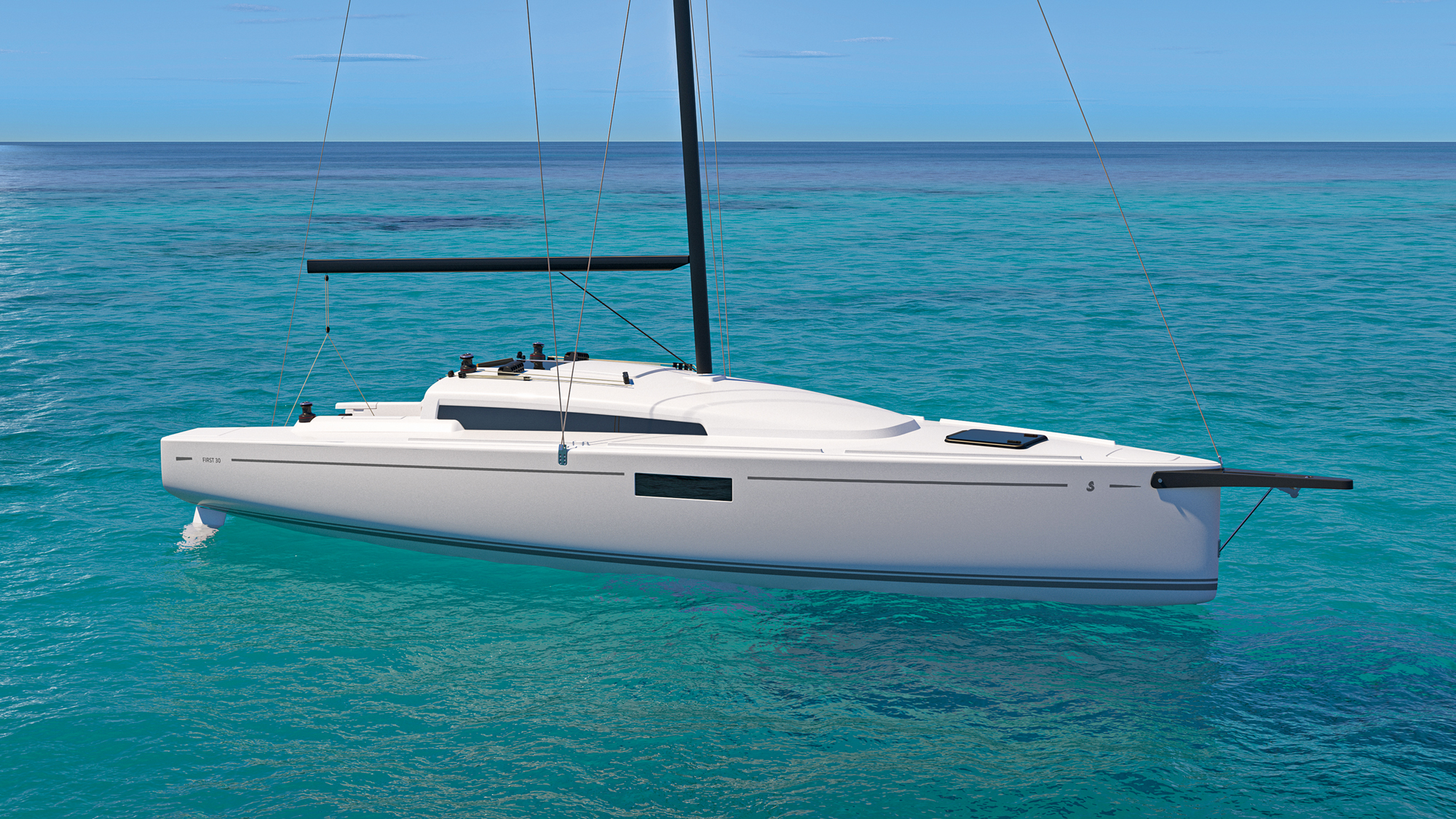The world’s largest yacht manufacturer thinks it has found the answer to sailing’s 'what’s next' question with the launch of the new Beneteau First 30, a planing cruiser designed to make high-speed fun affordable
Beneteau First 30 review: The affordable planing cruiser that’s fun and fast
When you consider how you got into sailing and how the next generation might do so, it prompts some searching questions. Is sailing dying as a sport and a pastime? Does our increasingly time-precious world demand a rethink, some sailing saviours, and if so, in what form?
Think back to the emergence of snowboarding. Skiing looked endangered. The glory days of Klammer and Maier’s downhill racing were being elbowed out by a young baggy-pants-wearing brigade. Then something glorious happened – carving skis were invented.
These hourglass-shaped planks seemingly changed the game overnight. What the rad folk were doing on boards, whether in powder or parks, could now be done on skis. It got cool again and hasn’t looked back since.
Perhaps sailing needs its own carving moment. Is this it? The world’s largest yacht manufacturer thinks so, with the launch of this exciting new model.
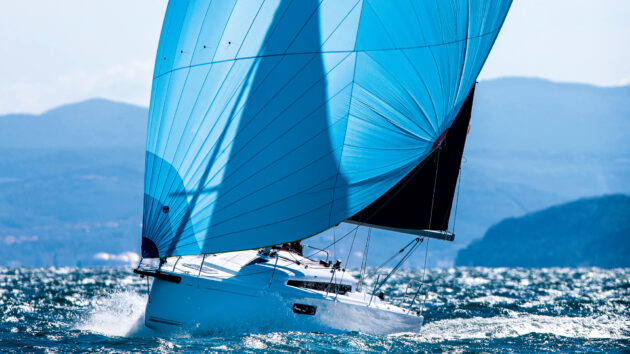
Relatively narrow beam (under 3m), low wetted surface, and weight kept to just over three tonnes means the F30 rises onto the water easily and is sporty in breeze. Photo: Uroš Kekuš Klev
The plane phenomenon
Why plough through the water if you can glide over it? Whether by power or sail, if you could free yourself of your own wake to go faster with less noise and wash, you would, wouldn’t you? That feeling of lightness and speed is addictive.
Yet how many planing yachts have you sailed? The answer is likely very few. In terms of the offerings from production yards over the last two decades, I can count them on one hand.
They need certain physics on their side, the right hull shape combined with sufficiently light construction. The Pogo 30 was a groundbreaker in that respect, and in some ways, what we’re seeing here is replicating that concept, 10 years later, with an updated and skinnier hull shape.
The Beneteau First 30 takes Sam Manuard’s brilliance and adds Seascape’s proven lightweight construction methods (keeping it to three tonnes), building on the First 36 they created two years ago.
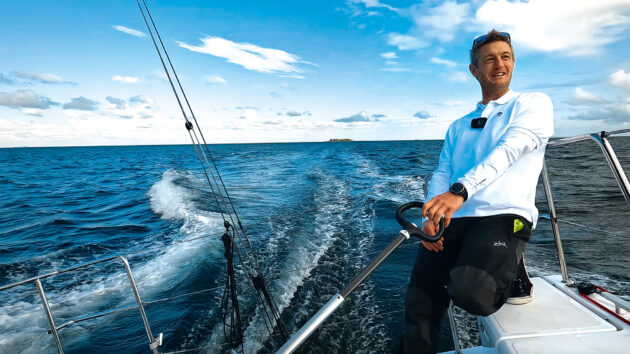
Direct tiller steering and long, smooth streaks rather than wake, means grins of joy for Toby. Photo: Uroš Kekuš Klev
It also benefits from Beneteau’s industrial scaling and resultant pricing. And, crucially, it makes the sailing bit easy.
Just look at it: an unassuming white boat, modern without being overtly broad or racy. It’s a cruising yacht after all, with a two-cabin interior, a saloon, galley, heads, hot water, cockpit benches, a swim platform etc – so it’s easy to picture yourself spending time aboard.
However, the vast majority of cruising yachts, while pleasant to sail, rarely offer the excitement of a sportsboat. To get that, you generally need to pay big sums for exotic composite construction (and then put very little inside them).
Article continues below…
Beneteau First 36 review: Is this the best First yacht in years?
You might not appreciate it at first glance, but this could well be the best performance production yacht we’ll see…
Beneteau’s new planing First 30: A step change for the French giant
The First 30 was Beneteau’s first sailing yacht when it launched in 1977 and it has since built nearly 3,000…
But, and this is an enormous ‘but’, cruising doesn’t have to feel like you’re driving your house around.
That’s where Seascape comes in. This Slovenian brand, formed by two Mini Transat sailors, Andraž Mihelin and Kristian Hajnšek in 2009, quickly proved itself with its Manuard-designed sportsboats, again built for fast, fun planing sailing rather than racing.
Beneteau saw Seascape’s growing appeal and bought the company in 2018. This F30 was developed by that Seascape team, is built in Slovenia, and Mihelin now heads up the First range.
So you can see the direction the First marque is headed. An ‘affordable’ price was a core objective, with the initial €100,000 tag below most other new cruising boats today (that’s for the bare boat with engine, rig, electrics, plumbing, galley and upholstery).
A club racer or weekender pack adds sails and electronics for €16,000. The Oceanis 30.1 starts at this price, but few other production yards still offer a yacht at this size. Crucially, Beneteau met and stuck to that €100,000 price tag.
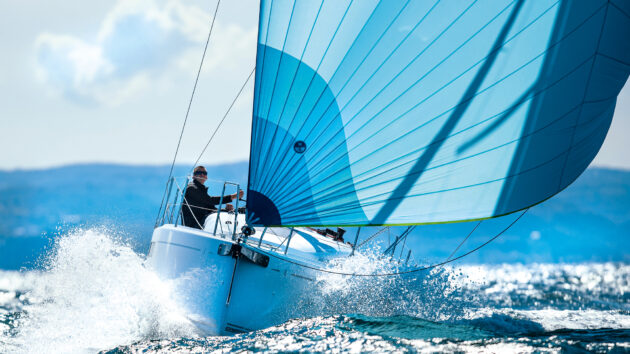
Fullish bow for dry planing and some forward cabin space. Photo: Uroš Kekuš Klev
All talk no trousers?
Ever since this new First 30 was announced I’d been itching to sail it, yet worried it wouldn’t live up to the ‘effortless joy of planing cruising for everyone’ hype. After the first hulls rapidly sold, we finally arranged a test around the weather forecast, in July in Denmark, with Per Cederberg, the Danish dealer for Seascape/First.
And while it’s not a flawless yacht, I can now say after sailing it over two days in a range of winds, that the F30 lives up to and in some ways surpasses those ambitious promotional promises.
The sailing is not about white-knuckle pace. Just the simple joy of planing, with ‘simple’ being the operative word. It’s genuinely easy to entice the yacht onto rather than through the water.
Perhaps the most pleasurable revelation during our trials was just how readily this was achieved, even in moderate winds. Despite a truly memorable sleigh ride in 20+ knots for a long spell, averaging 13-14 knots, the F30 really showed its prowess in the more marginal planing conditions.
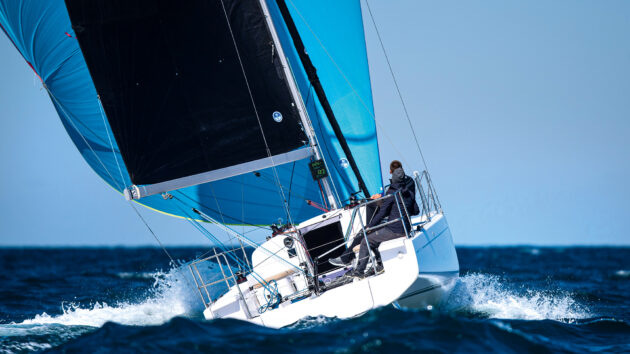
The F30 keeps the cockpit, controls and sails simple for the helm and crew to enjoy planing speeds. Photo: Uroš Kekuš Klev
Perhaps it hooked me because I could imagine myself sailing this with friends and family enjoying this playful speed. Crucially, to achieve this elevated state of planing, we didn’t have to drain the last drops of fuel and water out, nor did I have to go on a strict pre-sail diet or cut my toothbrush in half.
We just stepped on the boat (which hadn’t been used in a month), pottered out of the marina, hoisted sails, and the F30 did the rest.
During the two days, we saw its full potential (apart from surfing). In terms of figures, this equates to 6-6.5 knots upwind, 8-9-plus knots two-sail reaching and 8-13-plus knots spinnaker reaching. In sensation, however, it brings so much more.
Okay, so it wasn’t all ‘plane’ sailing. After all, some uphill work is inevitable if you want to enjoy going down. But we found beating on the F30 can be quite enjoyable too.
Granted, we only had some moderate chop rather than proper waves, but it’s no scow slammer. It’s a fun little yacht to tiller-steer, super light and direct. That it consistently tacks quickly through 80-85º means you can get places upwind.
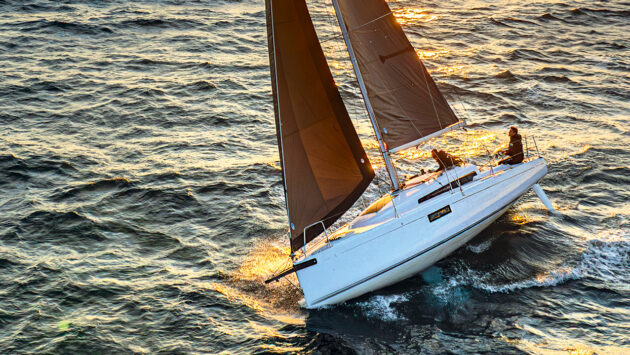
Easily trimmable for upwind ease and fun, as long as you control heel angle well too. Photo: Vid Slapnicar
In the lighter breezes of 8-10 knots it’ll maintain speeds in the early 6 knots range at 45º to the true wind. Once into double figures, it’s easy to hold 6.3-6.5 knots.
But this brings us to arguably its biggest downside – the angle at which you have to live with sailing upwind. Yes, monohulls heel, especially powerfully-rigged small monohulls.
But aboard the comparatively narrow F30, this really can be steep when close-hauled, despite its relatively high ballast ratio (35%) and deep, standard keel.
Well heeled
Sturdy moulded foot supports either side of the tiller provide crucial bracing, and this soon results in a workout as your leg muscles are constantly braced, while you’re pressed up hard against the guardrails to stay secure.
Or you can stick your head out below the top guardwire, akin to driving with your head out of the sunroof. If they are tall enough crew brace against the leeward bench, if not, the optional cockpit table could prove useful.
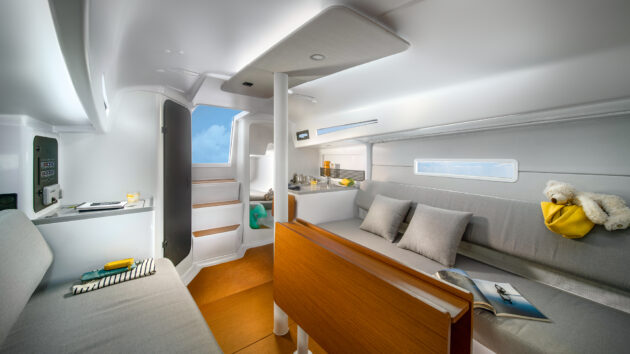
Tha Saloon provides plenty of space. Photo: Branko Ceak
The test boat had the traveller and German sheeting set up (instead of the simple standard A-frame), but a solution for leading sheets aft for short-handing would be beneficial.
Tail bags for the companionway winches that don’t clog up the cockpit bench seating area would also keep things tidier.
Once the breeze rises into double figures, the boat is fully powered up, and you need to adjust to this. While pinching feels natural, it’s not the answer as you’ll just keep heeling and go sideways.
Depowering the sails helps reduce some heel, and the simple, effective rig assists here. The Z-spars mast bends nicely thanks to a well-purchased backstay on a clamcleat.
With Cunningham, outhaul and sheet also cranked on, you can invert the mainsail, hence we didn’t need to reef in the stronger breeze. Easing the sheets can also improve heel and pace, a worthy trade-off for a few degrees of pointing.
The genoa sheets are rigged through floating thimbles inboard to coachroof winches, but Cederberg rigged up a simple Dyneema purchase from the shroud base to make an outboard lead, which worked well in the stronger wind.
If you go afloat for the sheer enjoyment of sailing you would, of course, have cracked sheets by now, but it’s nice to know that if you do need to get from A-B, and B is upwind, you can get there efficiently and enjoyably.
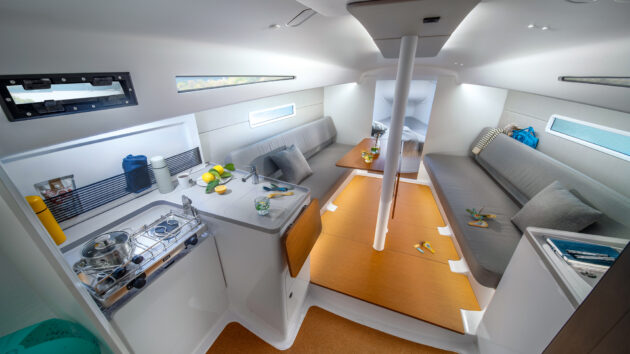
Both saloon and galley provide the essentials for comfortable cruising. Photo: Branko Ceak
Lighting it up
Next comes the real fun. Early predictions said the First 30 would be able to plane in 13-14 knots true wind. As marketing predictions are typically optimistic, I was certain we’d need more puff, but as I was to discover, you can plane in those wind strengths, easily, and without even hoisting a fancy sail.
But when you do unleash some extra firepower, you get to feel the boat light up properly. The F30 is spellbinding. Picture those clips of Fast 40s and TPs, sending it downwind, whitewater spewing down the decks as a full crew stack the windward pushpit, except here there were two of us aboard, dry in T-shirts and shorts, relaxed and chatting away.
It’s by far the easiest monohull yacht planing I’ve experienced. The test boat didn’t have an autopilot fitted, so it can get busy when flying a kite (with no sock or furler).
The deep, aft-slung twin rudders keep her tracking true, but going through gybes and drops demands some concentration. In the Force 5 conditions of our first session, we never stopped planing under fractional kite, making 10.5-13.5 knots.
It was thrilling sailing at 140-150º to the true wind, accompanied by the tell-tale high-pitched hum when it really lights up (over 13 knots). In fact, it makes it easy enough to get cocky and I managed to spin the F30 out, broaching a couple of times while focusing on filming rather than helming.
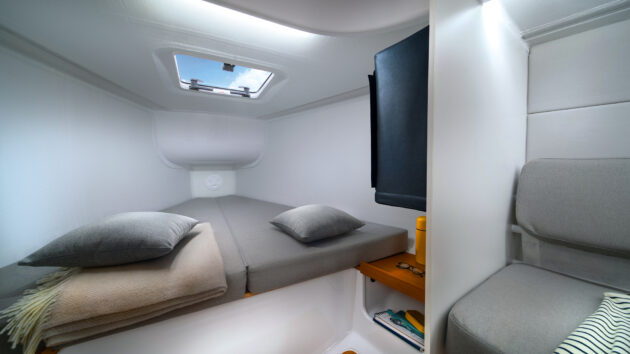
Good sized double berth in the forward cabin and a large hatch provides natural light – but stowage is scant. Photo: Branko Ceak
It was our second session in lighter breeze under masthead spinnaker which proved to be one of my most enjoyable afternoons sailing. Despite the wind only averaging 10-13 knots true, we were again treated to almost non-stop planing at 8-10+ knots (the wake separates at around 8.4 knots).
Hoist, set and forget, and just sail to the luff of the kite, as we reached and gybed between wind farms and islands or shoals. Speeds matter little when you’re planing in flat water.
It’s just such a pleasant feeling, especially with such little effort. I wanted to keep going. And surely to leave you wanting more is what sailing needs right now.
What’s the catch?
Once the show’s over, you can fire up the engine, power through a rain squall as we did, drop an anchor, swim from the platform, take an inflatable out of the deep cockpit locker, attach shorepower, have a shower, cook a meal – simply enjoy the normal cruising amenities.
So, no, there are few drawbacks to that performance. A little less cockpit comfort perhaps, smaller tanks, fewer gizmos, less refrigeration space, but there are still comforts enough.
You could ask about IRC ratings but that’s missing the point. If you want a handicap racer, there are plenty of Js, Xs and JPKs out there. Beneteau knows the big market is cruising and that the key to this new category of planing cruisers is keeping them simple for average sailors to sail.
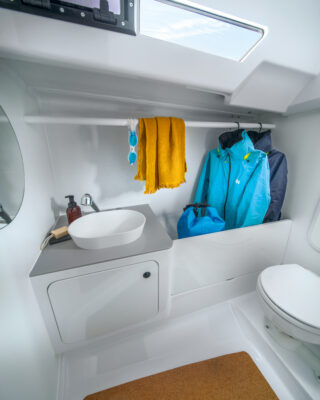
Full length rail is a useful hanging space for wet gear in the heads. Photo: Branko Ceak
How have they managed to build a planing yacht to this price? Using a fully cored and vacuum-infused hull and deck helps keep it light, a glassfibre composite keel grid for the cast iron T-keel loads adds stiffness, while a conventional hull liner with slots for standard plywood bulkheads helps make it quick and cost-effective to produce.
Pure Design also helped the yard strip weight, especially with GRP excesses. The F30 provides relatively comfortable space in two cabins, a large heads, workable galley, and long, comfortable saloon, while designer Lorenzo Argento has softened it with smooth cork flooring, a timber table and trim.
Standing headroom (1.81m) at the foot of the companionway, where the sole is the bilge, is paramount to comfort. It’s also a relatively minimalist fitout, with clever solutions to keep weight down.
Deck or hull lining is used sparingly; the rest is simply painted GRP. Some parts where lining meets bare hull may look a little ordinary, but in general, this wipe-clean finish approach works, reserving the comfort for where it counts, such as the thick ply saloon berths and smart indirect lighting.
The saloon benches are long enough to sleep on (2m), with backrests that fold outboard to add width, while the table is sturdy and large enough to seat six comfortably. Where the forward cabin provides a good-sized double berth with a large hatch above, the aft cabin feels more constricted.
The inboard side of the double mattress has very little headroom below the cockpit and therefore may better suit a single adult or kids.
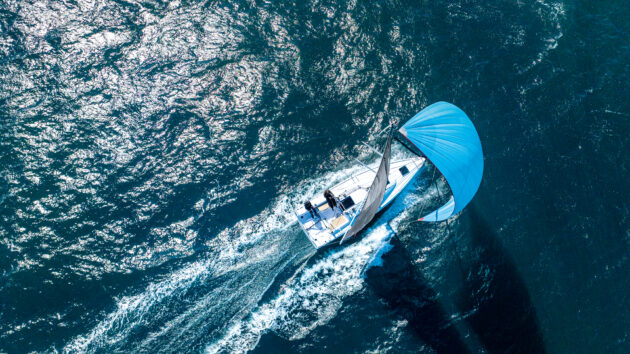
‘When you unleash some extra firepower the boat lights up’ Pgoto: Vid Slapnicar
The only option for proper stowage in the cabins is in the form of small removable textile lockers, but these come at an extra cost. Also optional for the cabins are ultra-thin and lightweight magnetic doors, as used for the heads – a clever, minimal solution for some privacy.
The heads compartment features a long rail above a deep well, ideal for hanging wet weather kit and lifejackets.
The galley is simple, practical and spacious, with a two-burner hob, a sink, double bin, drawers and a fold-down board to extend the work surface. The standing desk-style chart table also extends this space and includes an ice box or optional fridge.
Companionway steps lift 90º to access engine essentials such as oil, impeller, belt etc, but with no other access panels, changing the gearbox oil and oil filter could prove frustrating.
The generous cockpit locker, where the water separation filter is housed meanwhile, is the yacht’s garage, with enough space to swallow an inflatable dinghy and a sail. Aft panels in here and the port aft cabin allow constricted access to the steering gear each side, so those fitting an autopilot will want to make sure it’s within reach.
 If you enjoyed this….
If you enjoyed this….
Yachting World is the world’s leading magazine for bluewater cruisers and offshore sailors. Every month we have inspirational adventures and practical features to help you realise your sailing dreams.Build your knowledge with a subscription delivered to your door. See our latest offers and save at least 30% off the cover price.
Note: We may earn a commission when you buy through links on our site, at no extra cost to you. This doesn’t affect our editorial independence.
Verdict
So is the F30 a saviour? Like any superhero, it has its flaws, yet it’s instantly lovable on a simplistic level. And it just might help make sailing more enjoyable and engaging again. Crucially, you don’t have to be French, you don’t have to be an expert sailor, you don’t even have to be good. You can take this F30 out two-sail reaching and plane away. It offers a genuinely sporty feel aboard a yacht I could really imagine cruising aboard. In performance terms it nails it, but that comes with caveats. The twin rudders provide good grip, but it can still be a little tender. You don’t want too much lead below if you want the boat to be able to take off, but we did round up a couple of times under kite, while it heels a lot upwind. You can’t reach both sheets from the helm, finish is minimal in some areas, the double berth aft lacks headroom and interior stowage is a little scant – but if you’re still reading these small print negatives it’s not a yacht for you! The F30 provides tangible, fast, fun cruising. It gets you back to playful, fuss-free sailing at speed. Arguably, only the might of Beneteau could do a production-built performance yacht at this price – that hull number 100 recently sold is unsurprising. “We want people to start dreaming about sailing again,” says Mihelin. Well I’m certainly still dreaming about my F30 sail.





